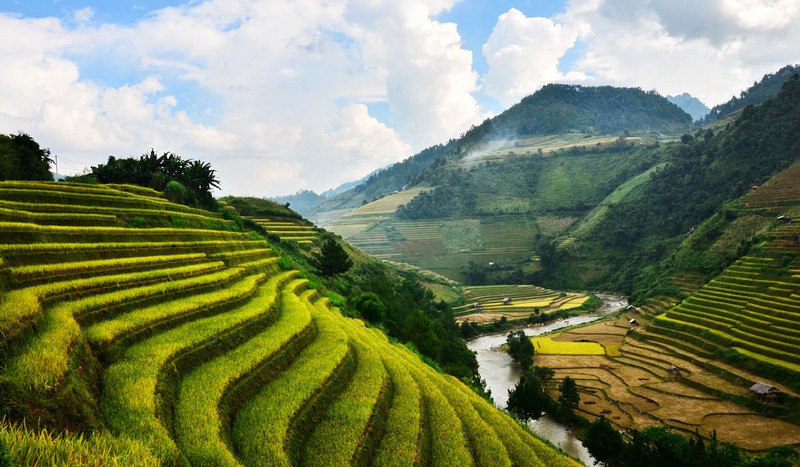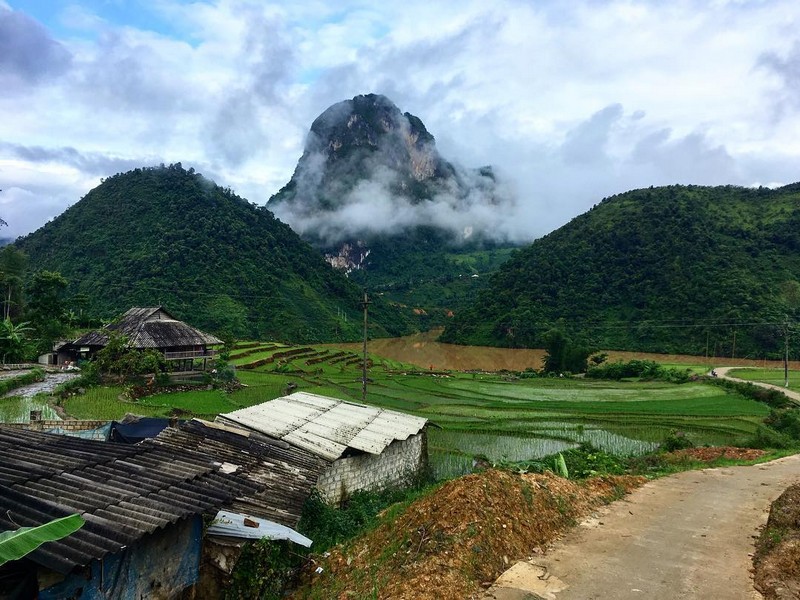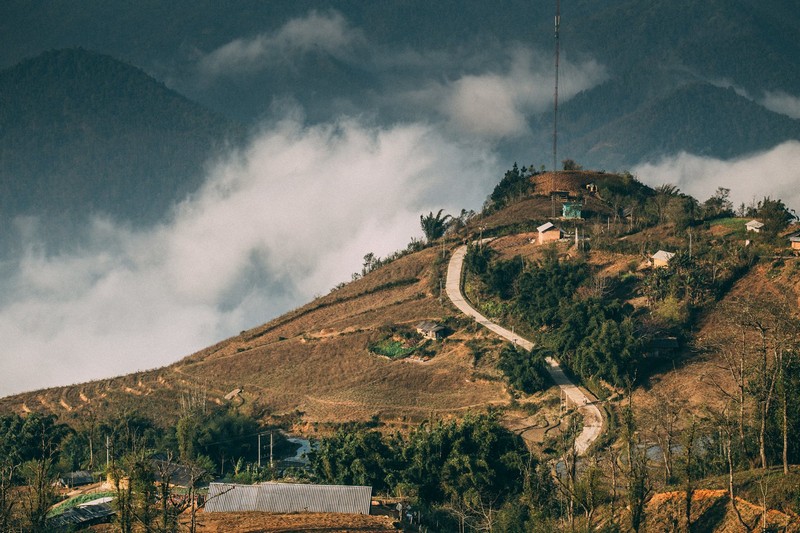(#wanderlusttips #Vietnamnorthwest) If you have travelled to the mountainous Northwest of Vietnam during autumn you will have experienced the beauty of its people, the landscape, the golden terraced fields covering the mountains from their top down to the streams in the valleys.
[rpi]
Road 32 has been expanded upward to Binh Lu junction, perfect for travellers wanting to discover the beauty of the Northwest. Every autumn, the scenery and the roads running through it exude a golden glow mixing with the colour of the sky and the rice fields below. The rice fields during harvest season are lit up, as are the expressions of travellers getting ready for their next adventure. After doing a careful maintenance check on their bikes and filling the gas tank, they are ready for their next trip. The smell of the season’s milkwood-pine flowers filling the air is the cue for them to start riding.
We chose a familiar route to explore the beauty of the mountains in autumn. Starting from Hanoi, we passed the tea hills in Thanh Son, and then found ourselves amid the golden rice fields of Mu Cang Chai, travelling up north to the legendary O Quy Ho, the ancient town of Sapa, and then along the difficult mountain roads in Muong Hum, passing Y Ty peak to return to Lung Po – where the Red River enters Vietnam.
The intoxicating aroma of rice in Mu Cang Chai

Mu Cang Chai is located about 300 kilometres from Hanoi, but seems much further away. It is a destination popular with visitors from both Vietnam and abroad. We have become familiar with the place as we visit it every harvest season. Despite having been here a few dozen times, this trip still made our entire group nervous and excited. We bid farewell to Hanoi, which was subdued in the soft sunlight of mid-autumn, while crowds of people rushed into the city centre for work. During the early sunshine, we quickly passed the immense green tea hills of Thanh Son, and then Khe pass and Ach pass. If you fancy a hot cup of Shan Tuyet tea stop at Suoi Giang, the ideal place to sip the hot beverage. Ancient tea trees with trunks as wide as an arm span grow atop a misty mountain and provide the finest tea. We travelled down Bo Hon hill toward Nghia Lo. When we could smell hay and ripe rice in the wind, we knew we had arrived in Muong Lo.
Despite being early autumn, Tu Le valley was chilly with cold air from the surrounding Khau Pa, Khau Than and Khau Song mountains, filling the valley. When we reached the valley, it was twilight. The last sunlight of the afternoon shone down on the rice fields, and we could smell glutinous rice. The Northwestern region is famous for its Tu Le rice, which is not available anywhere else and only planted during one season every year by the Thai and the H’Mong people. When cooked, the sticky rice needs no added flavours of beans, peanuts or coconut, but has its own tender sweetness that only this mountainous region can add. Its stickiness is not too wet and not too dry, satisfying even the pickiest eater.
The path to Lim Mong nestled among the rice fields is dyed a bright gold colour that make the earth and the sky shine during autumn. A stream runs through the middle of the valley, which adds a delicate touch to the magical landscape. We drove slowly towards Khau Pha pass (its name meaning “heavenly horn”) – one of the four greatest mountain passes in Vietnam, the sun had just retreated behind the mountains, leaving only a soft light on the road. From the top of the pass, we looked down to the valley to fully comprehend the prosperous life here. One can only praise the hands of the farmers who have lived here for generations and painted a beautiful image between the earth and the sky. Amid the golden glow of the rice fields pop up the beautiful, multiple colours of the traditional dresses. H’Mong girls in multicolour dresses were harvesting, and a Thai girl wearing white was threshing with some young men. The picture of harvest season has been colourful since ancient times.
We travelled down the wide Road 32, with nothing to rush us. We bid farewell to our bus at Kim junction, and rented motorbikes to go down La Pan Tan, and then followed the dirt trails of farmers to visit Ta Chi Lu. The steep, small dirt roads, which crossed small streams at some points, were extremely slippery. The small dirt trails were quite challenging for us. However, the Gods are always fair. Making up for the tiring travel is the beautiful scenery. Ta Chi Lu valley lit up under the sunlight, reflecting a golden sky. We were speechless in front of this landscape, and stopped by the roadside to admire its beauty. A travel companion of mind is a photographer, and after taking a few photos, he sat down quietly. It is simply impossible to fully capture this beauty, and even he could only retain a mental image. During this season, Mu Cang Chai is illuminated with the colours of sunlight, the golden rice fields, the dresses and the simple lives lived in this mountainous region.
Tu Le, Khau Pha, La Pan Tan, Ta Chi Lu are just small corners and if time allows, I recommend you ride deeper into Chu Cu Nha, Thao Chua Chai, De Xu Phinh to fully soak in the beautiful landscape and the talented hands of the H’Mong. For generations, they have painted and coloured the prosperous picture of the Northwestern region. Do not hesitate to stop by a home you pass on the roadside. The H’Mong are very hospitable. A bowl of freshly harvested rice will make it hard to stop eating, and even more impossible to forget.
Sunny Than Uyen

Our group started making the journey to Y Ty. We bid farewell to Mu Cang Chai, covered in golden rice fields, and visited Than Uyen. The recently renovated Highway 32 can make inexperienced riders “road sick”. This gateway into Lai Chau province does not have as many rice fields as Mu Cang Chai, but still fascinates travellers when its illuminated by sunlight. Those who have visited this place in autumn will understand why. The golden afternoon sunlight dyed our path and the surrounding paddy fields beautiful shades or yellow. The sunshine was not too intense. It was gentle and had the golden colour of honey. If you stand by the roadside pond at the border between Than Uyen and Tan Uyen, you can fully comprehend the beauty of autumn in the mountains.
This pond is not too big, but large enough to satisfy the thirst of passers-by. The peaceful atmosphere is evident on each branch of the trees and each blade of grass. A few groups of small rocks stand in the middle of the pond, and children play together in the clear waters. On the other side of the pond is a grassy hill where a few buffalos roam. A scene that we thought only existed in a meadow somewhere outside Vietnam, now appeared before our eyes. Everyone was surprised and silenced once again, and we could only admire the view and exclaim: “It is so peaceful!” We quickly unpacked our folding chairs and started boiling water on our travel stove. The smell of the Suoi Giang tea trees, enhanced by the autumn weather and the atmosphere, made us forget about having to journey home. It was only until my companions started rushing that I sluggishly started riding again.
The turning wheels brought us to more sun-filled places in Lai Chau Province, and the tea hills in Tan Uyen saw us off to Binh Lu. From there, we turned right and prepared to conquer O Quy Ho Pass. This is the highest mountain pass in Vietnam, with an average altitude of 2,000 meters and over 40 kilometres long. We slowly travelled on the pass in the late afternoon. Most of us had to use 2nd gear or even switch to 1st gear on our motorbikes to climb the hills. O Quy Ho Pass is known for its hills and curves. Despite the smooth road, the ride is still a difficult one for inexperienced riders, because a little mistake can mean driving off a cliff.
When we reached Heaven’s Gate, the sun was starting to set behind the mountains. We made a rest stop by a few roadside barbeque shops run by ethnic peoples, where we looked down onto the road we had driven. Looking back at the paths winding up the hillside we had just passed, we truly got a glimpse of time and space. My travel companions had already started a fire to make coffee and grill some dried food that we had. There is nothing more awe-inspiring than sitting atop a mountain pass in the twilight, enjoying a view of the magnificent Fansipan mountain range, sipping on a cup of coffee and chatting with travel companions. Life, as the late composer Trinh Cong Son said, “is too short to be indifferent”.
The golden Y Ty and the sacred Lung Po

Sapa welcomed us with the chilling breezes of early autumn, and the smell of grilled corn and sweet potatoes emitting from streetside shops. This small town, situated between the mountains and forests, is a frequent stop on our journeys. We stopped by a restaurant we knew and enjoyed the typical dishes of Sapa, along with a few sips of Thanh Kim rice wine to warm up, and relax after a tiring trip, followed by a dreamless sleep in Sapa.
Sapa tourism is now more developed, with more services for travellers. You can spend 2 – 3 days around this town and still not be done exploring. We travelled down the hills to Ta Van and May bridge to admire the view of the golden rice fields, and visited the homes of the Dao people in Ta Phin village to see the stitching of their colourful traditional dress. If you love history, the ruins of the church in Ta Phin can take up your whole afternoon. If you prefer adventure, you can conquer Fansipan’s peak – the rooftop of Indochina at an altitude of 3,413 metes. If you are feeling lazy, taking a cable car across the Hoang Lien Son mountain range is a worthwhile experience.
We travelled 10 kilometres backward on O Quy Ho pass and turned right to Ban Xeo village. We then passed Muong Hum towards Y Ty, and travelled back on the Khu Chu Lin – Lung Po path. Can Quy Ho pass greeted us with its gentle curves glistening in the morning sun, which seemed to lull us back to sleep. I still remember the path around Muong Hum a few years ago. Floods and landslides have made the dirt road bumpy. Motorbikes, despite being more mobile and flexible, still struggle to climb each hill. Cars and buses have an even harder time, because the road is only big enough for the width of one car. And of course, only four-wheel drives with strong enough engines can conquer this road.
The stones, rubbles, and sand made the bikes skid when turning. Often times, the passenger had to push the motorbike through the hills and the areas where subsidence was too dramatic. If you enjoy off-road travel know that Muong Hum used to be considered an interesting off-road path, before the road was renovated. Now, after it has been connected to Khau Pha and O Quy Ho, Muong Hum path is no longer difficult for riders.
If you are tired, you can open your car window and let the refreshing air in, the view of golden rice fields covering the hillside from Den Thang, Y Ty to A Lu will amaze you. Muong Hum Lake seems like a giant mirror, reflecting everything. The bustling atmosphere of the harvest season is evident in each rice field. Y Ty rice is different from Mu Cang Chai rice, because it ripens two or three weeks earlier, and usually covers a larger area. We followed this small winding road, and were once again captivated by the stunning natural landscape. It was a cloudless day in Y Ty, which was unfortunate for us, but perhaps not everything can be perfect. The dirt houses of the Ha Nhi people, made of dirt walls as thick as 50 centimetres, roofed with dried grass and green moss, which seem to only appear in cartoons depicting a wonderland, appeared before our eyes.
From Y Ty, we travelled to A Mu Sung and then turned to the border patrol path. The road runs through rice fields and heads straight upstream along the Red River. The golden rice fields along the roadside hug the winding road we drove along. China is only a river away, covered in highways full of roaring cars. On the Vietnam side, there’s only small dirt trails, with a few concrete parts. Anyone who has travelled this road will see the beauty of the border region during the afternoon. Not many people live near the patrol path, all you can see are banana tree fields and containers filled with their harvest waiting to be distributed throughout the country and exported.
Several parts of the road are eroded, and other parts covered in weeds, so we did not travel too quickly. We rode slowly to fully revel in the love for our country. Lung Po – where the Red River enters Vietnam – is the junction of a small stream from Vietnam and a big river from China. The two streams meet to carry their water into the Red River delta. We stood silently by Milestone 92 and conducted a small flag ceremony for our homeland. Our country has been invaded many times, but is now at peace. The milestone stands silently in this scared and noble land.
On our way back, we encountered Milestones No. 93, 94 and 95. Back in Lao Cai province, we followed Vietnam’s longest highway to get back to Noi Bai (Hanoi) in just five hours, concluding our mountainous journey. Mu Cang Chai filled with the sweet scent of rice, Than Uyen illuminated with the hue of golden honey provided by the sunlight, mighty O Quy Ho pass towering between earth and sky, quiet and peaceful Sapa, fairy-tale Y Ty, and sacred Lung Po on the border, all will leave us with a lasting impression and follow us through our next trips. Simply put, life is filled with journeys.
TIPS
Itinerary
Day 1: Hanoi – Thanh Son – Van Chan – Tu Le
Day 2: Tu Le – Mu Cang Chai – Than Uyen – Binh Lu – Sapa
Day 3: Sapa – Muong Hum – Y Rat – Lung Po – Lao Cai
Day 4: Lao Cai – Hanoi
Do not forget to pack well
If you are a travel enthusiast, you are familiar with the required necessities of a long trip. Warm clothes to protect you during chilly autumn evening in the mountains, a first-aid kit with basic medicine to prepare you for unexpected circumstances. Do not forget to bring personal IDs, because this journey takes through many border areas and you will need to report to the border police for guidance. A small pot to boil water for coffee, and a small notebook to document your journey. Do not forget your camera and charger. You will need to wear comfortable travel outfits, and trekking shoes, which allow you to comfortably explore every destination. If your group travels in several cars and buses, it’s best to be equipped with radios to communicate with each other quickly and easily.
Travel in your beloved car
Unlike motorbikes, a car can be more troublesome when it breaks down on the road. Thus, vehicle inspection and maintenance is required before any long journey. Do not ignore worn tires or think “I’ll change them after this trip”. You should change tires, engine oil, and check the coolant. Do not park too close to a cliff or weak spots. You should make a rest stop when you’re too tired. Do not drive when you’re tired and sleepy, as a few careless moments can cause you your life.
Article & photos: Tran Giap
Wanderlust Tips | Cinet

